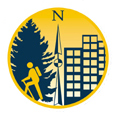GGR & PL CLASSES
-and-
PRM CLASSES
Degree
&
Certificate
Programs
Geography
B.S.
Extended Geography; Geographic Education; Geographic Information
Management (GIS);
Remote Sensing
Public
Planning B.S.
Land Use Planning;
Environmental Planning; Tourism & Recreation Planning; GIS & Planning;
American Indian Planning
Parks
& Recreation Management
B.S. & Certificate
M.S.
Applied Geospatial Sciences
Geographic Information Certificate
Master of
Administration:
Community Planning
Request Info on our Degree Programs
Contacts &
Resources

CITING ONLINE MATERIAL
by Michael B. Quinion
return to Department Writing Guidelines
Introduction
------------
This is a suggested format for citing the most common types of online
material, derived from advice given in various sources (listed at the
end). The sources also serve as examples of the formats suggested. Details
such as the order of citation elements and the format of dates
are matters for the house style of the publisher.
E-mail and Usenet news articles
--------------------
The standard form of citation is:
<author's name> <<e-mail address>> <subject> Article <<message-id>> in Usenet newsgroup <newsgroup>, <date>
1. Take the <author's name>, <e-mail address>, <subject>, <message-id>, <newsgroup> and <date> elements from the message header (see RFC1036 for further information if necessary).
2. Enclose both <e-mail address> and <message-id> within angle brackets. You may break either across lines, but if possible arrange for breaks to occur only at punctuation separators (but not on hyphens, and don't ever *add* hyphens).
3. In the case of a crossposted article, cite only one newsgroup (most suitably, the one in which the article was actually read).
4. Because Usenet articles are ephemeral (very few are archived, or if archived, easily accessible), if you cite a Usenet article in a printed publication you may optionally omit the Message ID.
5. For the same reason, you should retain copies of Usenet articles you cite until they are no longer needed.
World Wide Web, FTP, Gopher, Telnet
--------------
The standard format is:
<author's name> <title of document> <<URL>> <date of document> (Accessed <date accessed>)
1. Use the URL (Uniform Resource Locator) to identify the source of the material, as specified in RFC1738. This begins with a code for the type of access involved ("http://", "ftp://", "gopher://", etc.). The appendix to RFC1738 suggests that URLs in citations should be prefixed with "URL:" and surrounded by angle brackets; for example:
<URL:http://www.bodley.ox.ac.uk/bardhtml>
However, including the "URL:" prefix seems ugly and unnecessary, as the angle brackets and access code suffice to identify the code as a URL.
2. If the accessed document is dated internally, use that date for the citation. If there is no date given, use the date at which it was first accessed (prefixed by "Accessed" in parentheses, as shown above). Optionally, give both (for example, if you have any reason to think the document may have been amended since its first creation).
3. Give filenames as you first encountered them, including suffixes indicating compressed format, such as "gz" or "zip".
4. Take care to preserve case in network server directories and filenames, as it is usually significant.
5. You may break URLs across lines, but if possible arrange for breaks to occur only at punctuation separators (but not on hyphens, and don't ever *add* hyphens).
Sources
-------
1. Barrett, Alan <barrett@lucy.ee.und.ac.za> "MLA citation style for internet documents?" Article <3phppu$t6k@lucy.ee.und.ac.za> in Usenet newsgroup alt.usage.english, 19 May 1995.
2. Berners-Lee, T., Masinter, L. & McCahill, M. [ed.] "Uniform Resource Locators (URL)" Request for Comments 1738, Network Working Group <ftp://ftp.demon.co.uk/pub/doc/rfc/rfc1738.txt> Dec. 1994. (Accessed 3 Feb. 1995)
3. _Chicago Manual of Style: For Authors, Editors and Copywriters_ (14th edition), University of Chicago Press, 1993, ISBN-0-226-10389-7, pp. 633-4 [not as comprehensive as the other style manuals cited here, because it is just that bit older].
4. Gibaldi, Joseph _MLA Handbook for Writers of Research Papers_ (Revised Fourth Edition), Modern Language Association of America, 1995, ISBN 0-87352-565-5, pp. 160-67, 176-78 [the most recent and the most comprehensive advice available; guidance is also given on citing etexts, CD-ROMs, databases and other electronic sources].
5. Horton, M. & Adams, R. "Standard for interchange of USENET messages" Request for Comments 1036, Network Working Group <ftp://ftp.demon.co. uk/pub/doc/rfc/rfc1036.txt> Dec. 1987 (Accessed 19 June 1995).
6. Johnson, Floyd H. "Suggested MLA Style Guide" <ftp://ftp.netins.net/ showcase/nwc-iowa/pub/int-refs.txt> 1995 (Accessed 17 Apr. 1995).
7. _Publication Manual of the American Psychological Association_ (Fourth
Edition), American Psychological Association, 1994, ISBN 1-55798-241-4,
pp. 218-222.
8. Wainwright, Mark <markw@harlqn.co.uk> "MLA citation style for internet documents?" Article <D8Gv79.IMB@harlequin.co.uk> in Usenet newsgroup alt.usage.english, 12 May 1995.
return to Department Writing Guidelines
